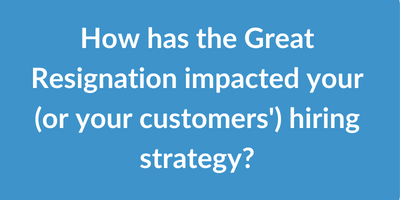

Crosschq Blog
The Great Resignation or Reshuffle? Either Way It's Here. What's Next for Recruiters?

In the United States, what has been somewhat reluctantly dubbed “The Great Resignation” is now officially “The Great Reshuffle”. A new generation of workers has risen with different needs, goals, and demands, and the pandemic has opened the floodgates for a complete workforce revolution. People aren’t simply opting out of the workforce; they are reevaluating what work means to them and what place it has in their lives. They are moving into positions that make more sense for them.
What is the impact of the Great Reshuffle?
A record of 4.3 million U.S. workers quit their jobs in August, setting a quit rate record of 2.9%.
While many of these resignations are due to employees opting out of difficult, low-wage jobs in retail and hospitality sectors, quitting reaches across a broad spectrum of the workforce.
These workers aren’t sitting at home doing nothing. Who are they, why did they quit, where are they going in their professional lives, what do they want from employers, and how can they be enticed into roles waiting to be filled? These are the questions facing recruiters.
What started the shift?
This isn’t solely a pandemic-driven phenomenon. While the global COVID outbreak accelerated the trend, Forbes notes that the rising quit-rate has been constant since 2009 — on track to reach the same record highs in any event, although most economists predicted it would be a number of years further down the road.
Now, however, the massive number of Americans unwilling to return to a broken status quo is causing bottlenecks as wages rise and businesses must decide how they plan to approach staffing shortages long term. How can companies bridge the gap between the past and the future of work?
The hiring decision is crucial and you’ve got to get it right.
“Hire more people” isn’t working as well as many companies hoped. A return to “normal”, it is becoming increasingly clear, isn’t in the cards; according to Forrester, 55% of the workforce strongly desires to remain working remotely at least a few days a week. More than half of U.S. workers from high earners to the lowest-paid cite flexibility as their top qualifier for a job opportunity.
While only 30% of businesses are seriously considering a fully remote model, 70% are now entertaining some form of hybrid work arrangement to meet worker demands and leverage the savings made possible by a distributed workforce. There are more than 10 million job openings (another record) in the current U.S. market, so where does that leave recruitment?.png?width=600&name=Great%20resignation%20blog%20600x100%20(1).png)
Traditional hiring isn’t working
Hiring in the US is a $70B+ industry with a 45% fail rate. Within 18 months, almost half of all new hires have left their companies. According to a recent Bankrate survey, 55% of Americans expect to search for a new job in the next 12 months. As workers reexamine their professional and personal priorities, hiring managers have new challenges to face in their efforts to snag the best and brightest talent.
The need for speed leads many companies to incentivize rapid hiring, seeking to fill roles swiftly and get a department up to full capacity — on paper at least. However, hiring indiscriminately can be a company’s downfall, as biases easily come into play when making snap hiring judgments.
As recruiters work quickly to keep pace with filling roles, they rely on imperfect gauges for candidate quality.
Organizations that use traditional, outdated methods for ranking job candidates (such as filtering by education, or scoring individual interviews) often hire the wrong people entirely. Crosschq data shows only a 9% correlation between interview scores and the quality of a new hire.
The ramifications of hiring the wrong person are far-reaching and costly; one industry leader pegs the cost of a new hire at close to a quarter of a million dollars.
How can companies go beyond resume checklists and interview scoring to leave bias behind and surface the talent they need to fill skills gaps and build a future-proof workforce? The answer is changing the recruitment mindset, to hire for skill sets and outcomes first and always.
The finish line isn’t the new hire’s first day on the job, it’s the productivity, culture fit, and retention of that hire for months and years to come.
Leah Knobler, Director of Talent Acquisition | Help Scout
"We are grateful we haven't experienced the "Great Resignation" in terms of turnover at Help Scout, but we have seen candidates we're hiring now want more time in between leaving their current jobs and starting a new role with us, probably due to the burnout everyone is feeling overall. We have definitely seen an increase in time to hire and time between offer and start date, so we factor that in when trying to plan for future hires and building out teams. Knowing roles may take longer, we've started posting them on our careers page and other job boards sooner and begin sourcing much earlier than ever before. "
Caitlyn Metteer Director, Recruiting | Lever
"A lot of our customers are now looking into internal mobility strategies and how they get better leverage their current talent and give them new opportunities to learn and grow on different teams in different roles. Every hire counts, so making sure they're providing high-value recruiting across the board is also critical to success. The first touchpoint new hires have is with the recruiting team, so that interaction can make or break the relationship."
Shifting to outcome-first hiring
A critical component of improved retention lies at the source of each new hire. Companies that focus on hiring for outcomes ask questions like the following early in the recruitment process:
- Will the new hire align with our existing company culture?
- What do they add in the way of diversification and an expanded mindset?
- Can they become productive quickly, and continue to excel and grow?
The answers to these questions aren’t readily found in a resume, and maybe overlooked or ignored in an interview and skimmed past in a traditional reference check. Without these answers, it can be impossible to identify the best talent for each job opening and fit various options together to form a cohesive team.
The challenge for recruiters and hiring managers is they don't have data at their fingertips.
The current hiring marketplace presents an unprecedented level of complexity both on a personal level, as workers are reevaluating what it means to work; and on a company level, as organizations are trying to figure out how to react to the new environment.
Executives are looking for more reliable, meaningful information on candidates so they can find new hires who are a good match for the organization leading to better retention. Data is the answer. Forward-thinking leaders are updating their hiring tools and processes to better utilize data insights for improved hiring decisions.
Leah Knobler, Director of Talent Acquisition | Help Scout
"My advice would be to work even harder to keep your current team happy so you don't have to experience a Great Resignation to begin with! Managers should know if their team is engaged and about what motivates them, and if not, managers should be having those conversations regularly with their team. Are they motivated by new challenges? Making an impact? Working with other smart, great people? Do they see a clear career path at your company? And then of course everyone should be analyzing compensation packages and making sure top talent is being well compensated, especially since candidates can easily leave current roles and get large raises elsewhere."
Caitlyn Metteer Director, Recruiting | Lever
"The 'Great Resignation' has been in full swing for a few months now. For hiring managers, encourage people within your team to post for open roles and further amplify your company's voice on social media, ensure you're checking in with your team to see how they're doing to prevent them from leaving as well and leverage the team you have for backfilling roles they have interest in."
Crosschq is the Solution
Crosschq is helping businesses find and retain their best workers with a suite of cloud-based tools called the Talent Intelligence Cloud™, leveraging machine learning and AI systems for the entire recruitment lifecycle from reference checks to retention.
Crosschq 360, an automated reference check process that takes just a few minutes to initiate, gathers consolidated feedback on candidates providing rating scores on attributes, skills, strengths, and areas for improvement, including averages and detailed background.
Hiring for outcomes is what makes the Crosschq approach unique. We help companies align with what they’re hiring for, to deliver what they're expecting on the other side. When hiring is done right, everyone benefits; the talent benefits because they are able to successfully do the job they were hired for, and the company benefits because it's achieving its business goals.
The Great Reshuffle is far from over. Companies that want to succeed in the new workforce landscape must be able to shift from traditional recruitment methods to make data-driven hiring decisions while navigating the wants, needs, and demands of the next generation of workers.
To learn more about how your company can recruit and retain the best talent, sign up for a demo with one of our Crosschq team experts today.
Take the Guesswork
Out of Hiring
Schedule a demo now



%20-200x43.png)







.png?width=400&name=Great%20Resignation%20or%20Reshuffle%20Piece%20(1).png)
